





















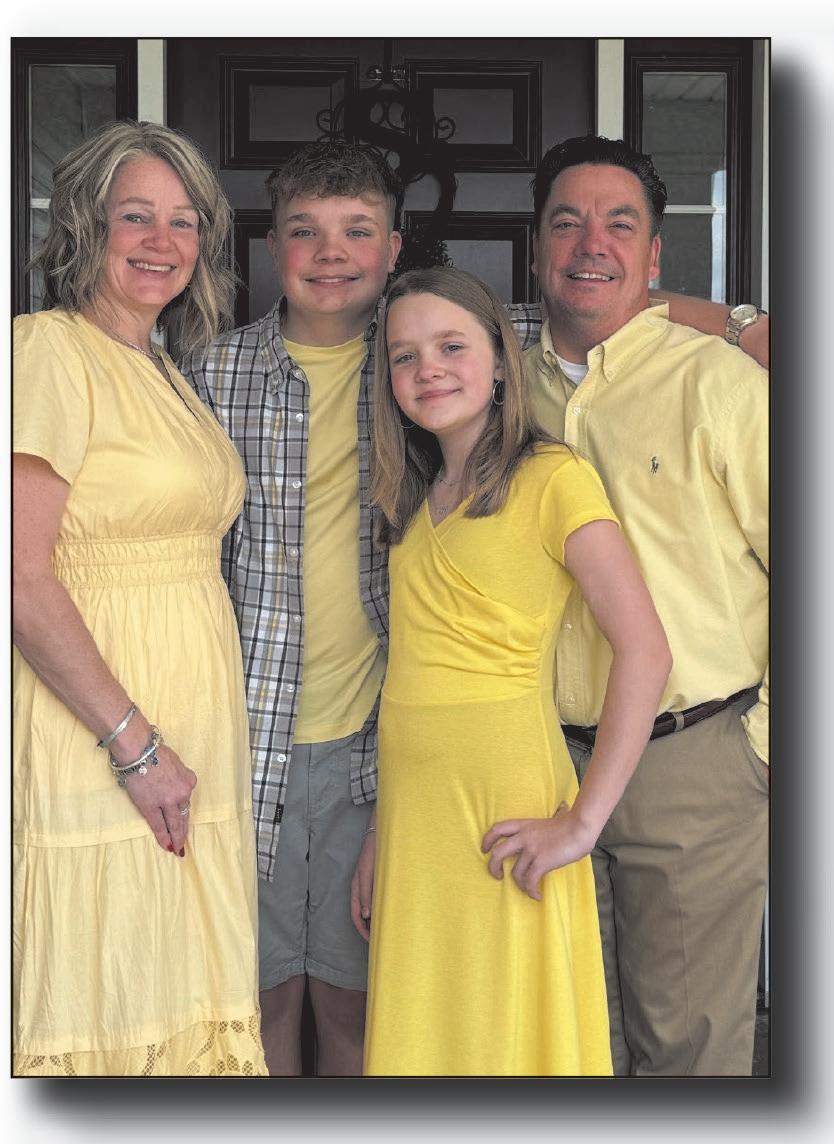



SUPPORTING THE HEARING HEALTHCARE OF OUR COMMUNITIES FOR 46 YEARS









































SUPPORTING THE HEARING HEALTHCARE OF OUR COMMUNITIES FOR 46 YEARS














By Paul Paterra
What started out as a joke turned into a party in the sky for Nancy Merckle.
And the Canonsburg woman was still feeling the thrill days after she marked her 90th birthday by skydiving.
“It was fabulous,” she said of the tandem jump. “It was scary in the beginning, but once I got out of the plane and started to free fall, I felt a little more confident. Of course, having that guy on my back helped. I thought, ‘Just don’t let me go.’”
Merkle turned 90 on July 1, but the aerial celebration came five days later at Skydive Pennsylvania, located near the Grove City Airport in Mercer.
A group of about 25 friends and family members were on hand to watch. Granddaughter Jessie Merckle, great-grandson Troy Wagner, 18, and his mother, Tiffany Wagner, jumped with her.
“They were so excited,” Jessie said of the crowd that had assembled to watch. “A couple of them were friends of mine who had never met (my grandmother) before and just wanted to come and see her. She has just been having the most amazing week. She felt so very loved. It was awesome. She’s been having a good time with it.”
The idea for Nancy Merckle’s jump stemmed from a joke at a family get-together.
“Two or three years ago, we were talking about Grandma turning 90 and what we should do to celebrate,” Jessie recalled. “Someone threw out skydiving and she said, ‘I’ll do it.’ We kind of joked about it for the past couple of years. She’s still in good health, so the closer we got, I thought that we should actually do this.”

Nancy Merckle celebrated her 90th birthday by skydiving.
Nancy’s only apprehension came during the plane’s ascent.
“I kept thinking how far up is this going,” she said. “It kept going up and up and up and up. Finally, he said to me that we were going to go. We were first, and that was scary. I had to squat in front of the opening and look down there and see how far down we were going.”
Once she hit the ground, Nancy admitted having a little trouble getting to her feet.
“My legs felt shaky and I couldn’t get up,” she said with a laugh. “We were all laughing. He was trying to pull me up and finally he just picked me up.”
When Nancy’s not jumping out of planes, she’s volunteering at Canonsburg Hospital, taking a weekly exercise class and tending to her garden. She also enjoys traveling, but has curtailed it to care for
her husband of 74 years, Jack, who suffers from dementia. He was not present for his wife’s jump but saw a video of the event.
“He was just so excited to watch her,” said Jessie, who is in awe of her grandmother.
“Doing this with your 90-year-old grandma – how do you top that with anything else?” she said. I think it’s the most wonderful thing that she’s 90 and she’s able to do this and do what she does. I hope to maybe do this when I’m 90.”
As for Nancy, she said she’d “do it all over again.”
“I was sore the next day, but I’ll take the pain with the fun we had that day. It was exhilarating, and it was fun. It couldn’t have been better.”
Courtesy of the Observer-Reporter




Are you tired of numberness, tingling, burning, balance issues, loss of sleep due to your peripheral neuropathy?
Barb M






Are you like most people with this diesease and have taken Gabapentin, Lyrica, Neurotin or other medications without results or improvements? Do your symptoms continue to get worse?
I am 100% better and looking forward to starting to go for walks again.
Wayne L I am back cutting the grass, walking through the neighborhood and doing more things.
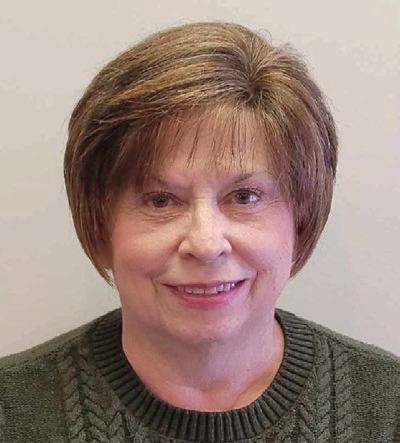
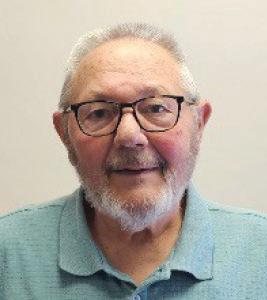
Take a qualifying survey to determine if you are a candidate www.MaryDancedIn.com


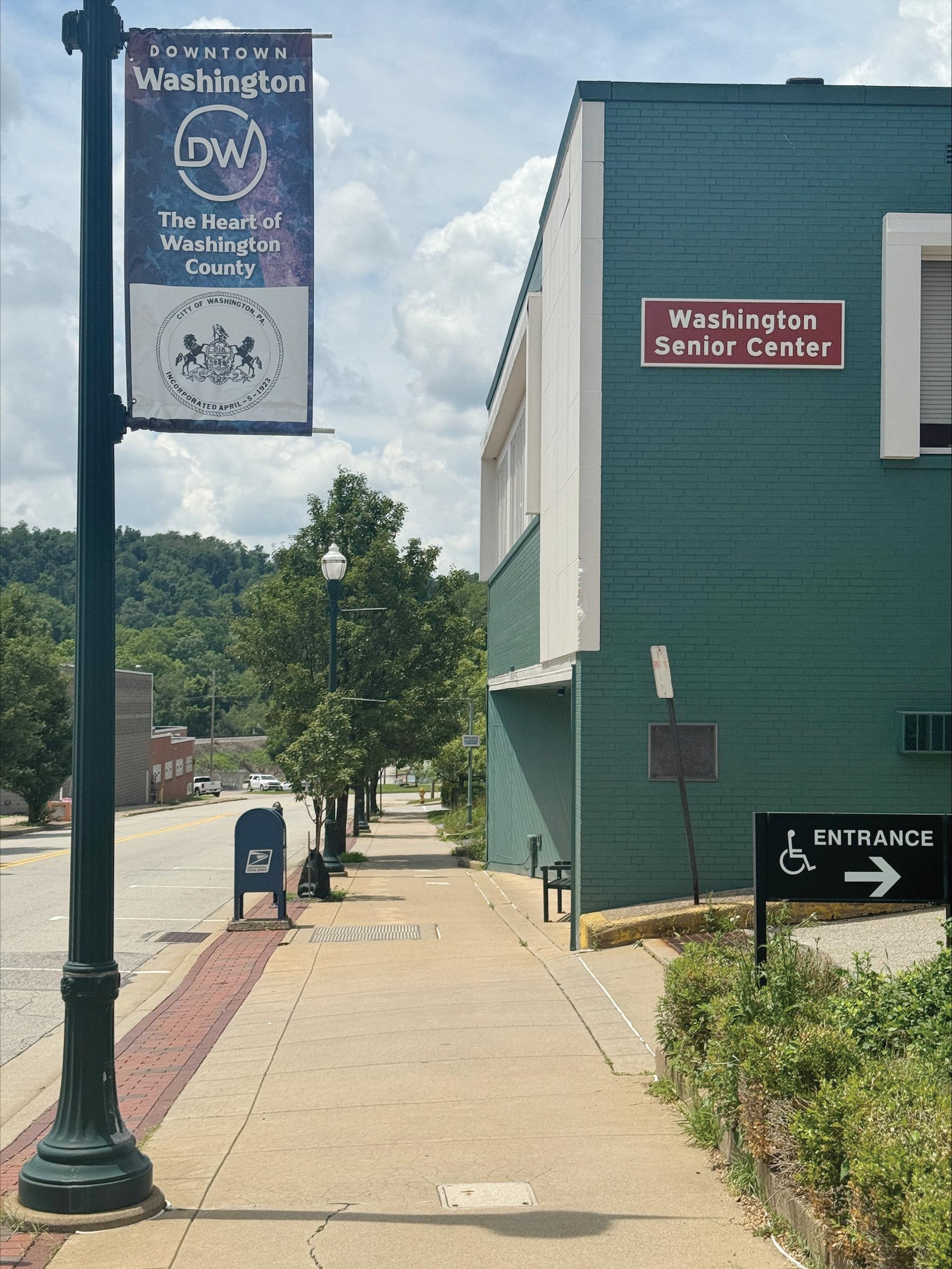
A longstanding hub for older adults in Washington County, the Washington Area Senior Citizens Center has recently given its façade a bright new look. The front of the building at 69 W. Maiden St. was freshly renovated, making the center even more welcoming to visitors. Inside and out, the center remains dedicated to its founding mission: as a non-profit, it helps meet the needs of senior citizens through programs that support independence, reduce loneliness, and allow seniors to live with dignity. For many of its 100+ active members, the center is a vital part of daily life – a place to share a nutritious meal and enjoy social companionship, especially for those who live alone.
The center’s daily luncheon program is a cornerstone: for a monetary donation, seniors receive a healthy meal and a chance to dine with friends.
Beyond lunch, the center buzzes with activity. From exercise and arts-andcrafts classes to computer lessons and Bible study, there are varied programs to keep minds and bodies active. Staff regularly organize outings – a trip to The Pennsylvania Trolley Museum, a Pittsburgh arts tour, or even a Gateway Clipper riverboat cruise.
Educational talks on topics like avoiding scams or proper nutrition are also offered, and volunteers even provide federal and state income tax preparation each year. The Washington Area Senior Center truly serves as a community center for older adults – a place to socialize, learn, and find support.
Help from community members is always needed. A key part of the center’s success is its volunteer team. The center is continually seeking caring volunteers for a variety of roles.
In the dining room, volunteers serve meals and clean up afterward each day. Kitchen volunteers assist with meal preparation. Others teach classes –from exercise and yoga to art classes. There is also an in-home meal delivery service: volunteers drive or ride along to bring meals to homebound elders in the Washington area.
No special certification is needed to help – just a friendly, helpful spirit. In short, whether you can chop vegetables, lead a fitness class, clear tables after meals, or simply chat and share a craft project, there’s a way to contribute.
The center and its vibrant programs rely on community support. Anyone interested in lending a hand or learning more can contact the center at (724) 222-8566 or visit washpaseniors.org. C ourtesy of the Observer-Reporter Advertising

By Paul Paterra
Cpl. Peter Helisek Jr.’s obituary ends with three words: “Candy, Candy, Candy.”
The sweet reference is a callback by his younger brother John to the years before Helisek left for World War II.
“Every day he would come home from work, he would bring me this little candy bar,” John Helisek Sr. said. “When I saw him coming down the hill, I’d start hollering, ‘candy, candy, candy.’”
John said his brother would hand over the candy (called Ice Cubes), pick him up and carry him inside.
By the time John was around 7 years old, his brother had shipped off to war, where he was killed on the beaches of Sicily, Italy on July 10, 1943 at age 25. According to his obituary, Helisek was taking part in the Allied invasion of Sicily at Gela Beach off the Sicilian shoreline.
There were few details regarding his death at the time, other than he was declared missing in action that day, his brother said.
“When they first told us he was missing in action, I remember my mom crying,” John Helisek said. “After one year, they had to put him among the dead.”
Eighty-two years after his death, Helisek’s remains were returned home to Brownsville, where he will be laid to rest today.
“It’s a big relief for me,” said John Helisek, 90. “I know my mom and dad would be real happy about it.”
John Helisek said his brother’s remains
were in a civilian cemetery in Sicily, where they were exhumed and brought back to the United States. They were identified through investigation by the U.S. Department of Defense POW/MIA Accounting Agency, along with intense testing and research.
Peter Helisek’s remains were in Omaha, Neb., until they were flown to Pittsburgh International Airport on June 18. There he received plane-side funeral honors from the U.S. Army 316th Headquarters Command.
On June 25, John Helisek recalled the last time he saw his brother. Peter Helisek and a buddy were home for a weekend after being stationed at Indiantown Gap. The family dropped them off at the New Stanton exit of the Turnpike.
“Just before he got in a car, he turned around and he waved to us,” John Helisek said. “That’s the last memory I have of him.”
Visitation for Peter Helisek was held June 27 at The Skirpan Funeral Home, 135 Park St., Brownsville; The Funeral Mass was held at the Historic Church of St. Peter in Brownsville and interment was at St. Mary’s Cemetery where full military honors were accorded by The United States Army and The American Legion Posts #940, #838, and #275.
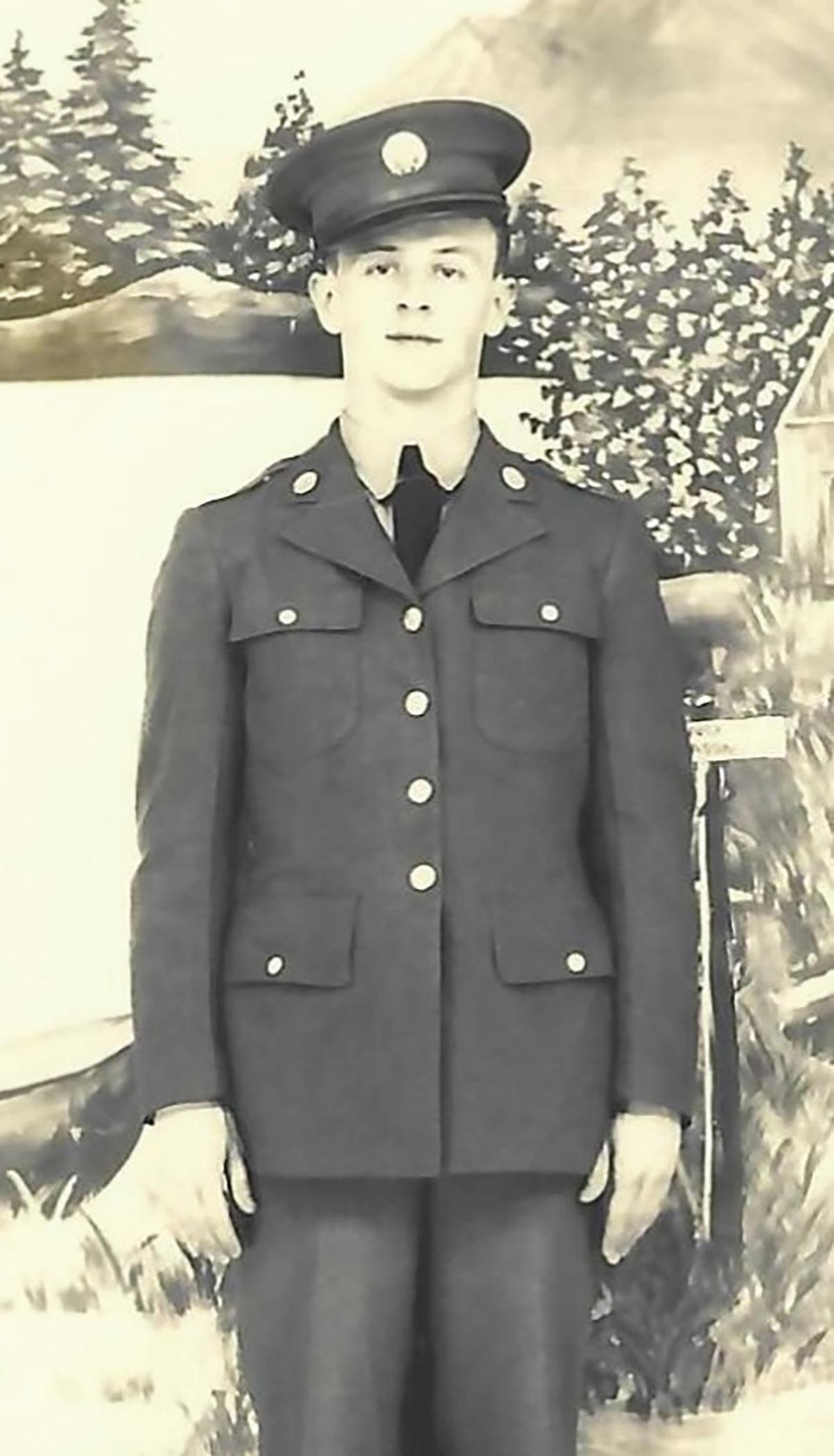
Cpl. Peter Helisek Jr. of Browsville
Courtesy of the Observer-Reporter

By Jon Andreassi
Last year on Memorial Day, Dean Stewart noticed that many of the flags marking the graves of veterans at Robinson’s Run Cemetery were falling over.
Bob Moreau, superintendent of the McDonald graveyard, said Stewart offered a fix.
“He approached me and said he noticed a lot of the flag holders were loose, the tops were stripped and falling off,” Moreau said. “We started pulling them a dozen at a time.”
Stewart, of South Fayette Township, said his father, along with many other relatives and close friends, are buried at Robinson’s Run.
“It just irritated the heck out of me when I saw the flags touching the ground,” Stewart said.
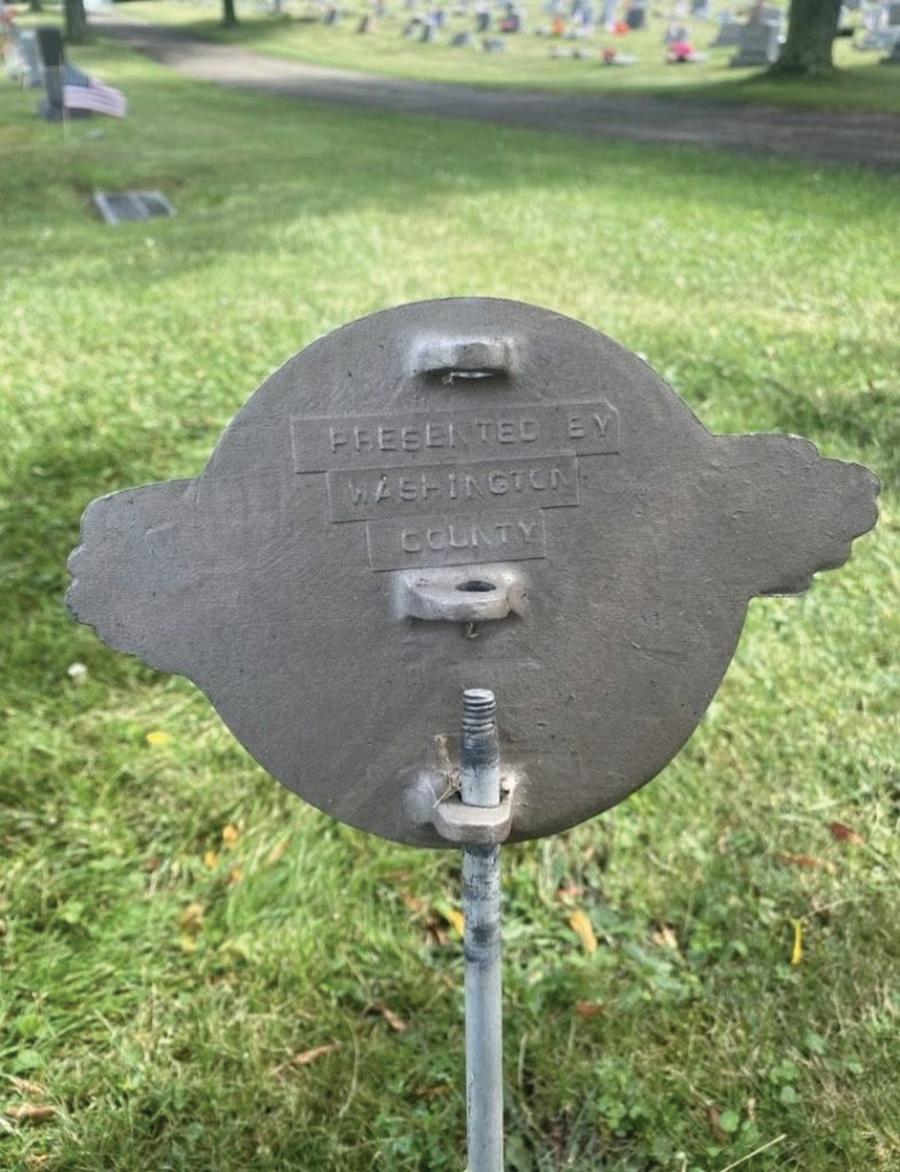
He estimates that he repaired close to 300 flag holders at the cemetery. For Stewart, the project was a way to honor the veterans resting there.
“People say they live their lives and don’t have any regrets, and I think that’s a lie,” Stewart said. “One of the things I have regretted is not serving the country. This in no way makes up for that, but the flags are sticking up straight.”
According to Moreau, veterans from conflicts dating back to the Revolutionary War are buried at Robinson’s Run.
He said that the flag holders falling into disrepair has been a common issue.
“We’ve been dealing with it for years. We’re up on a hill, the wind blows constantly,” Moreau said.
Stewart described the problem as an “easy fix.” He reinforced the holders with two stainless steel nuts, and used Loctite on the threaded rod.

do it. I think that would be really cool for a kid to do,” Stewart said.
“If you put Loctite on a thread, once it is set you have to heat that nut up to 300 degrees to get it to screw. I don’t think any of them will loosen up now,” Stewart said.
With the ease of the repair, Stewart thinks fixing these flag holders would be a worthwhile endeavor for Eagle Scouts looking for a project.
“I would be happy to teach them how to
When Stewart visited Robinson’s Run this past Memorial Day, he was happy to see there were no longer flags touching the ground.
“To me, all the soldiers out there were standing at attention,” Stewart said.






















Retirement is often characterized as a carefree time in life when adults who spent years in the workforce get to enjoy the fruits of their labors. But upon retiring, many retirees find themselves fighting boredom. A recent study from Indeed found that, as of March 2022, 3.2 percent of workers who retired a year earlier had already reentered the workforce. No two retirees are the same, and a host of variables, boredom among them, likely compelled recently retired professionals to go back to work.
Retirees who like the freedom of not working but are confronting a good bit of boredom can consider these tips to cultivate a new hobby that can help them pass the time in a rewarding and engaging way.
• Identify new (or old) interests. Many retirees discover new passions in retirement, while others turn back the clock and revisit favorite hobbies from their youth. A good way to begin cultivating a new hobby is to jot down a list of activities you always found interesting but never had the time to learn or became too busy to fully invest in. Some seniors hit the links for the first time in retirement, while others return to school to study subjects they find interesting but did not engage with during their college years. The options are endless, and jotting down a list of new or old interests is a great way to get the ball rolling.
• Embrace new ways to engage a passion. Virtual resources like online courses and book clubs conducted over Zoom with


fellow readers across the nation and possibly even the globe are a great way to cultivate a new hobby in retirement. Virtual resources can be especially beneficial for seniors with mobility issues.
• Consider locally based resources. Community parks departments and libraries may offer an array of free or affordable opportunities for seniors to engage with a new hobby. Parks departments may offer anything from cross country skiing tutorials to age-based hiking excursions, while libraries may offer weekly crafting sessions or wellness programs to local residents. In addition to providing fun ways to discover and cultivate a new hobby, programs offered through parks departments and local libraries are great ways to meet fellow retirees.
• Put your experience to use. Retirees with years in their field don’t have to go back to work to make use of their professional expertise. Contact local youth organizations or outreach programs sponsored by churches, libraries or local law enforcement agencies and offer to share your expertise with young people. Such opportunities allow retirees to continue to engage with their professions and help a younger generation of aspiring professionals gain valuable insight into fields they’re interested in.
There’s no shortage of ways for seniors to overcome retirement boredom and cultivate rewarding hobbies.
Courtesy of Metro Creative









At 25, George loved to spend time improving his home. At 85, he still can.






Community LIFE helps seniors confidently and safely live at home with an all-inclusive program and insurance plan. With eight Health and Wellness Centers throughout the region and transportation provided, you can drop by and have a cup of coffee, laugh with friends, and take care of your health all at once. For a community that’s full of LIFE, call 866-419-1693 or visit commlife.org to learn more.


At the Stephen R. Haky Funeral Home, we understand that life can be unpredictable. Pre-planning your funeral can bring peace of mind, not just for you, but for your family. Take the burden o your loved ones by making arrangements in advance, and let us guide you through every step of the process with compassion and care.
Peace of Mind: Make your wishes known and relieve your family of making di cult decisions during a time of grief.
Financial Security: Lock in today’s prices and protect your family from rising costs.
Personalized Options: Choose the services, ceremony, and details that re ect your unique life and legacy.
Start your pre-planning today with the Stephen R. Haky Funeral Home, where comfort meets preparation. We’re here to help you plan for the future—today.
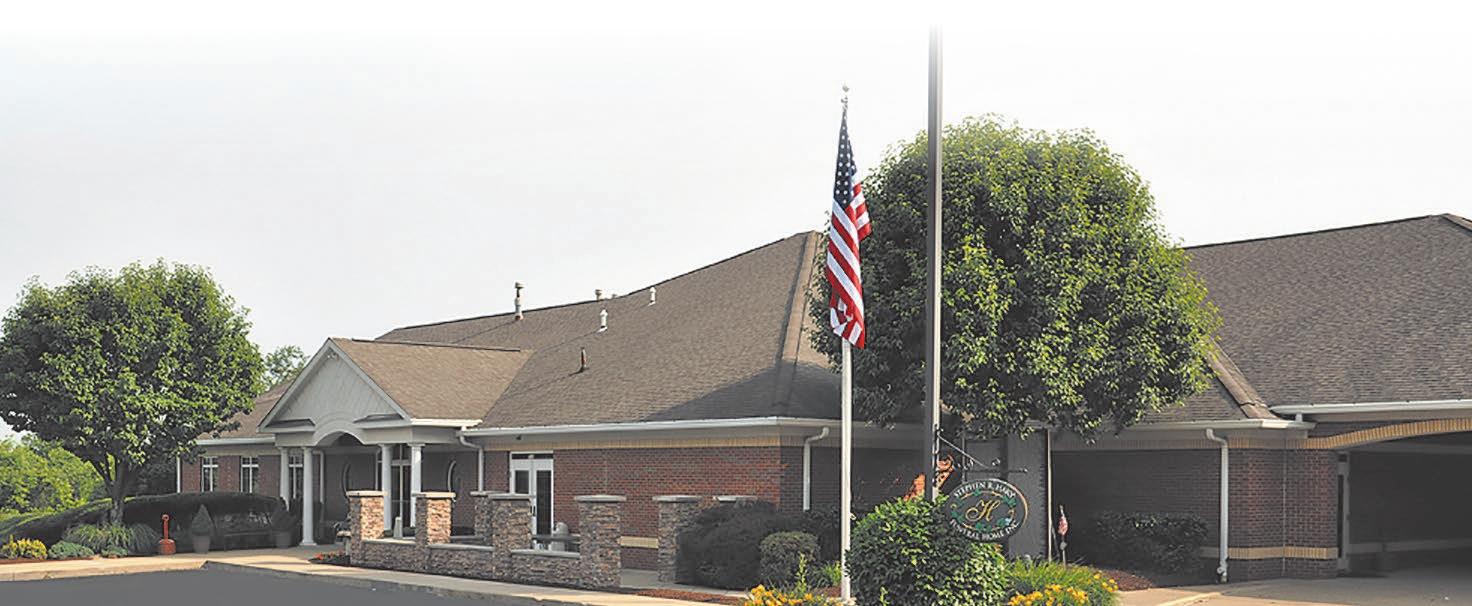




By Karen Mansfield
At 92, Barb Provenzano isn’t finished helping others.
Provenzano, of Houston, has volunteered for 55 years at UPMC Washington Hospital – she started in 1970, when Marcus Welby, M.D., was the most popular television show and Simon and Garfunkel’s Bridge Over Troubled Waters topped the music charts – and she is a fixture in the hospital’s gift shop.
“For me, volunteering is rewarding. I wanted to do something for myself and for my community, and I decided the hospital was the place for me to go,” said Provenzano.
On April 23 of this year, Provenzano, surrounded by volunteers and hospital staff, was recognized for her five-and-a-half decades of service as part of National Volunteer Week.
Established in 1974, National Volunteer Week focuses national attention on the impact and power of volunteerism and celebrates regular people who accomplish extraordinary things through service.
“Her compassion is remarkable. She’s just very compassionate to people,” said Donna Erlinger, president of UPMC Washington Auxiliary. “Sometimes just a smile is all you need to make a difference. People come here and they’re not always in the best frame of mind. With Barb, it’s just that smile, that nod, that little bit of encouragement that she gives that makes a difference. Her volunteering, for 55 years, is just amazing.”
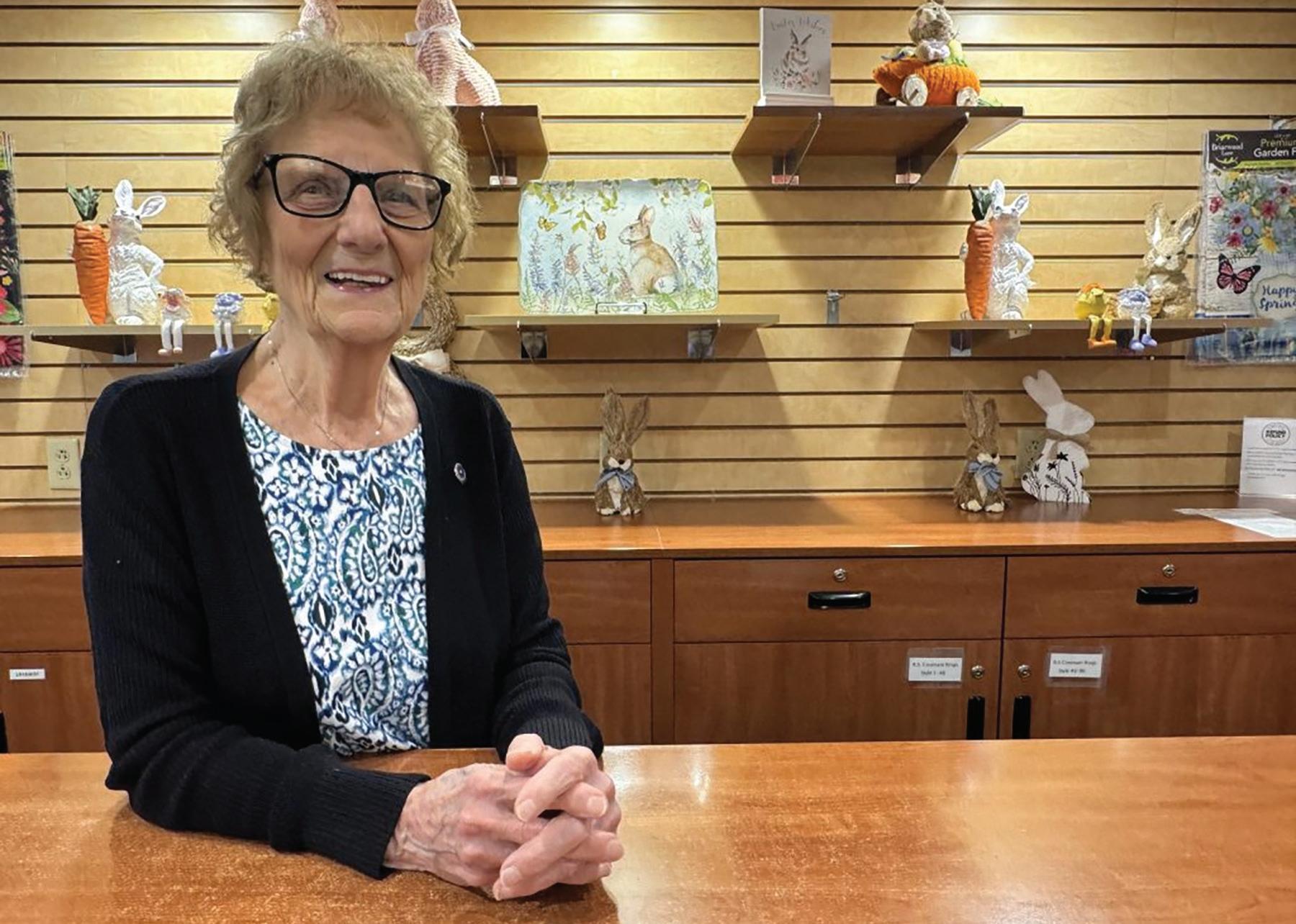
Provenzano’s volunteer path began when her mother-in-law offered to watch Provenzano’s two children one day a week so that she could have a day to herself.
“I wanted to do something worthwhile, something that would help people,” said Provenzano. “Being around people and knowing that I’ve done something that is worthwhile was important to me. ”
Since that time, Provenzano has logged 19,453 volunteer hours, mostly in the gift shop.
The biggest change, she said, was the closing of a lunch counter at the gift shop, which served top-notch food.
“The food served at the lunch counter was delicious. The gift shop used to be small, but when the lunch counter closed,
the gift shop got much bigger,” she said. Her volunteer efforts were supported by her husband of 51 years, the late Tony Provenzano, former owner of the popular Tower Restaurant.
“My husband said if I got paid for all the hours I volunteered, we’d be rich,” said Provenzano, with a laugh.
Provenzano’s daughter, Lisa Provenzano Steele, attended the ceremony and watched as her mother received a service pin.
Her mother’s volunteerism impacted Steele, who also volunteered at Washington Hospital until she began working full time.
“I always remember my mother volunteering,” said Steele. “She is a very giving
person, and she is a very loyal volunteer and very giving of her time. I was so used to her volunteering when I was growing up, it was a part of who she was.”
UPMC Washington isn’t the only organization Provenzano supports. She also is an active volunteer for Our Lady of the Miraculous Medal Church.
And, Provenzano, a native of Warren who worked for Bell Telephone (she relocated to Washington when a new district office was created) has lived life to the fullest.
In July of 2024, at age 91, she went skydiving, something she had wanted to do to mark her 90th birthday, ever since she saw former President George H.W. Bush celebrated his 90th birthday with a jump.
Still on her bucket list: a helicopter ride and a hot air balloon ride.
She also enjoys playing competitive bridge and spending time with her son, Mark, a pulmonologist at Butler Hospital; daughter Lisa, and her seven grandchildren and three great-grandchildren.
“It’s been a ride,” said Provenzano.
Provenzano plans to continue volunteering at the gift shop.
“It was on my bucket list,” said Provenzano. “I had planned to do it for my 90th, and I said last year that no matter what, I was going to do it, and I did and I loved it.”
“I hope to keep doing this for a few years at least. I like getting to see people and talk to peo-

ple. It’s rewarding to me. It just fulfills you to do something good,” she said. “I would advise people to be active. No matter what you do, be active. Don’t sit around watching TV all day. Get up, even if it’s just to go for a walk. Don’t sit at home. Volunteer if you can. It’s worthwhile.”
Courtesy of the Observer-Reporter





By Garrett Neese
What separated the Pennsylvania farmers brewing a rebellion over a pint at the Black Bear Tavern from the actors reenacting their arguments on Main Street in Washington Saturday?
Looking at the calendar, about 230 years. But by location, only 80 yards.
The Whiskey Rebellion Festival returned to downtown Washington July 11 and 12, bringing a range of historical reenactments and demonstrations along with food and drink vendors, tours, shopping, live music and a whiskey and spirit walk.
The festival launched in 2010 as a way to celebrate the area’s connection to the history of the Whiskey Rebellion. Between 1791 and 1794, farmers angered by an excise tax on the whiskey they made from their grain eventually mounted an armed rebellion, which ended when George Washington led an army of 13,000 militiamen to quell the uprising.
On Main Street, visitors could tour the Bradford House, where a federal tax collector had knocked on the front door of rebel leader David Bradford.
As an added connection, “It’s even the same door,” said Tracie Liberatore. Executive director of the Bradford House Historical Association, she also serves as the festival’s program director.
“When you’re young or when you’re old and you’re learning about history, you don’t realize it’s right here,” she said. “So there’s a lot of local awareness. With the local awareness, with all these people, it’s helping the local businesses, it’s helping the local mercantile because we have people selling stuff

Jorma Borish, Moshe Dale, Wyatt Denman and Maximilian Brown in mustering drills during the Whiskey Rebellion Festival
here, and the bands, so it kind of helps the community as a whole.”
New this year, the George Washington Hotel added needlepoint and weaving demonstrations, along with the Soldiers and Sailors historical gaming group.
And as they do each year, the popular Whiskey Rebellion Street Theater found a new angle for the story, playing out six scenes among the rebel organizers, charting the course from their displeasure over the new tax to their boiling point, the tarring and feathering of a tax collector.
Crowds formed the sidewalks along Main Street near the top of the hour to catch the latest installments, which mixed historical figures like Bradford with invented character Samuel Clayton, a town drunk who be-
comes a revolutionary firebrand.
The tarring and feathering in the final scene drew the biggest crowd response, with onlookers shouting “Tar!”
Pete Fernbaugh, who played the town crier, said the display helps people engage with history.
“I think it’s important to understand that even though we do have a strong, centralized government, it wasn’t always approved of, especially out here on the frontier, because they weren’t always taking our interests into consideration,” he said. “So I think it’s important for people to understand who fought before them, who created this world that we now live in, this country that we now live in. Any event that can do that is a worthy event.” ~ cont. on pg. 20



At the Bradford House and the Meeting House across the street, people could also experience more about life in the 18th century, playing old-fashioned children’s games with a hoop and stick, or practicing penmanship with a quill.
Jorma Borish of Strabane led volunteers in militia drills and musters outside the Bradford House; afterward, he explained to crowds the history of the Whiskey Rebellion.
Borish is a docent at the Bradford House, though he prefers to think of himself as a “living historian.”
Saturday, he wore the uniform worn by George Washington’s forces during the Battle of Fort Necessity, his first taste of combat. Sweltering under multiple layers in Saturday’s mid-90s heat gave him an appreciation for what those soldiers endured.
“This time period — or any time period — really isn’t out of reach,” he said. “Everything about it is still relevant. These were real people, and to be able to understand, I like to immerse myself.”
Last year’s festival drew about 7,000 people, the biggest crowd yet. Although numbers weren’t in yet, Liberatore said crowds had been packed for events Friday, including the night’s closing performance by the Washington Symphony Orchestra. Saturday was shaping up to be more of the same. Word of mouth keeps the festival growing, Liberatore said.
“I even tell my family and friends who don’t come, ‘You have to come see what it is, and then you’ll come back,’” she said. “And that’s what’s happening. I had somebody that I ran into earlier who drove an hour and 20 minutes to come here.”
A frontier history enthusiast, Maximilian Brown of Brentwood had wanted to come
to the festival since hearing about it last year. Saturday, he participated in a militia and muster drill outside the Bradford House.
“I think it’s awesome,” he said. “I love seeing all the costumes and the historical sites. It’s so cool to be able to see all the stuff I read about so much.”
Courtesy of the Observer-Reporter

Reenacters plan the appropriate response to the whiskey tax.






By Paul Paterra
Kathy McClure still remembers the thrill of being a child climbing the stairs to the children’s section on the second floor of the Eva K. Bowlby Public Library.
Her mother would regularly drive her and her four younger siblings from New Freeport to the Waynesburg library.
“We lived far into the country, and she just didn’t have the time to bring us to story time,” she said. “But we always came every two weeks on grocery day and got our books. So it’s like a second home.”
That connection has deepened over the years, leading to multiple staff positions at the facility.
Now, after more than 30 years with the library, McClure is moving on to the next chapter.
McClure, who has been the library’s executive director since 2005, announced last month she is retiring effective Jan. 2. Since she made the announcement, person after person have come forward to tell McClure how much she’ll be missed and what an asset she’s been to the community. So did the regular library patrons she told ahead of the official news.
“It’s been a very humbling experience so far,” she said. “And I think it’s probably going to get more emotional. I really had mixed feelings. If I was just a bit younger and my health was just a bit better, I would be staying a bit longer. But 68 is a good age to start thinking about taking some time for yourself.”
McClure joined the library staff in 1994 as director of youth services and assistant director, also serving as acting director twice in that time after other directors left.
After her children were of school age, she’d
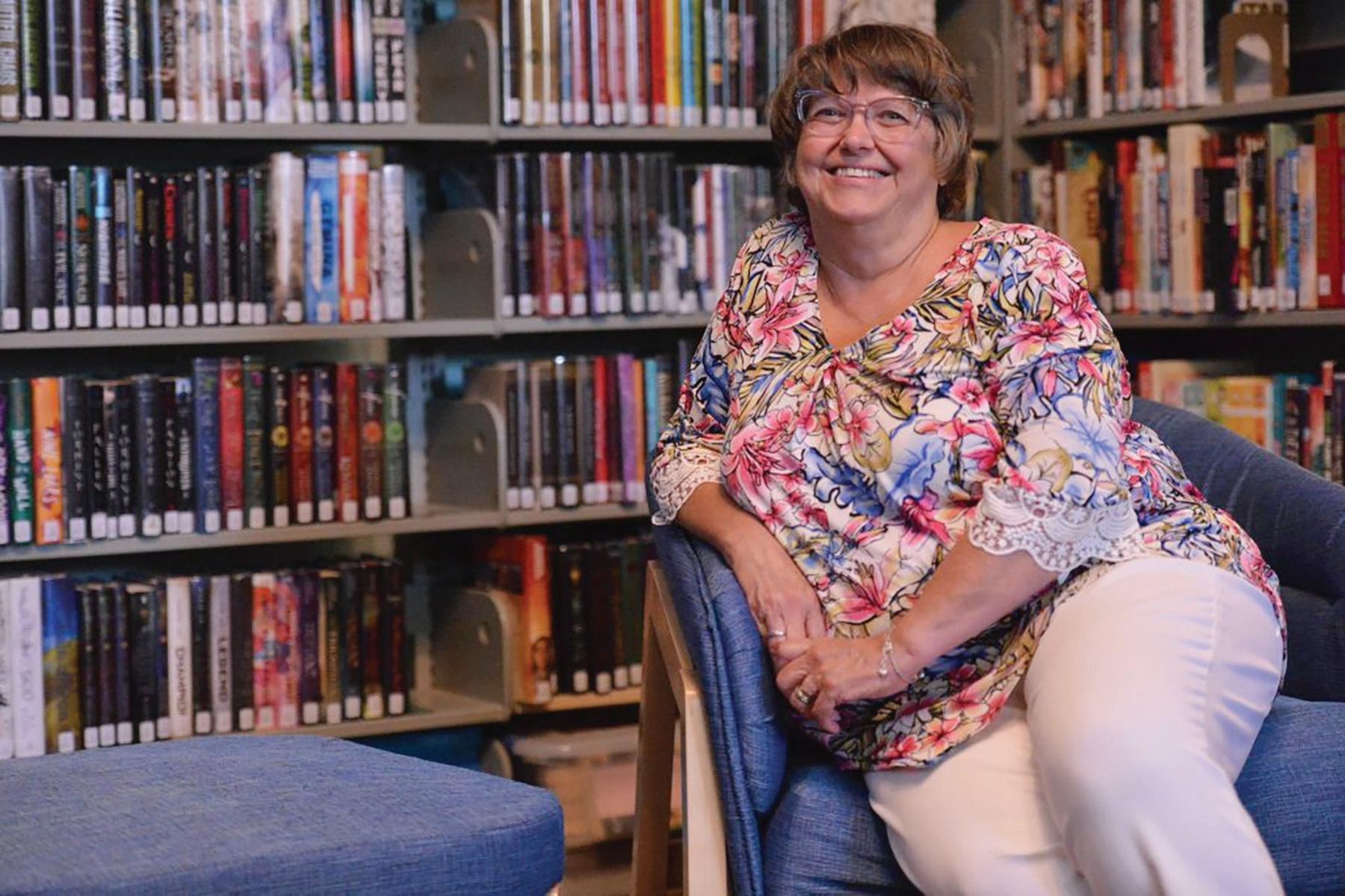
gone back to school at what was then Waynesburg College for a degree in elementary education. Once the youth services position became open, she jumped at it. It gave her the flexibility to continue raising a family while also using her love of libraries to plan programs, choose books and teach children.
In 2005, after the third director left, the board approached McClure about taking on the top position.
It wasn’t an automatic yes.
She loved her work in the children’s department, and getting “to plan really exciting programs and see their little faces all light up.”
But she also knew how hard it was to go through transitions when another director left. She went back to school at the University of Pittsburgh for her master’s degree in library and information sciences, and as-
cended to the top spot.
“I feel very privileged to have been able to serve the community in the way that I have,” she said. “I feel like the library is such an important asset to any community. It gives free access to all information for anyone who is willing and able to be able to come to the library to receive that information.”
As for the progress they’ve made since McClure started, she didn’t know where to begin.
Enamored of the “beautiful, historic building” they use, McClure has kept up maintenance with new roofs, porches and drainage. The library added a parking lot, and also a gazebo, where children get to enjoy summer programs in the shade.
The young adult room is being redesigned to replace “fuddy-duddy furniture” with something more inviting, she said.
There’s also the ongoing work on making
sure the shelves are stocked with new, relevant material.
“That is not something that is intuitive to most people, so it’s something that you have to train people to do,” she said. “And I feel that we’ve done that.”
The library’s influence has expanded beyond the walls of the Bowlby, doing outreach at day care centers, preschools, and nonprofits.
Over the years, McClure was blessed with supportive boards who backed “all my crazy ideas” if the funding was there.
She’s also been supported by family.
When her children were young, they would come to help cut things out or paint. After her husband retired from the mines, he joined the staff as a custodian.
Her granddaughter has worked at the library for six years. Her grandson, who’s been mowing the yard for years, is now an intern.

“It’s become a family affair,” she said. “It’s going to be a huge change for all of our lives. But I feel I’m well past retirement age, and it’s kind of time to hand the reins over to somebody else.”
McClure had let the board president and governance chair know she intended to retire, to give the board plenty of time to plan for a replacement. Her official letter of retirement came in April.
And what qualities would McClure like to see in a new director?
For one, whoever succeeds her will need to love the community, and have a good sense of what it needs and wants.
They’ll also need a strong knowledge of library science — and of business, and of how to manage a staff.
“You’re (human resources), you’re building management, you’re the library director, you’re library services, you’re the finance management,” she said. “You’re just wear-
ing many, many hats.”
McClure won’t fully step away from libraries just yet. To ease the transition, she’ll stay on as Greene County’s library system administrator for another year.
She’ll be willing to provide guidance to the new director, but doesn’t want to interfere.
“I feel like when a new person comes in they should have the same opportunity to be able to make the library the library that they want it to be,” she said.
Once the new director is settled in, she’d like to come back to the library as a volunteer.
First, she and her husband are going to travel more. Starting in January, the quick trips to see her sons — one in Alabama, one in Kentucky – can afford to last a little longer.
“We started our family young, so it’s kind of time for us to be together,” she said.
Courtesy of The Herald-Standard

“They















Maintaining physical health as a body ages is an important consideration, and often one of the first things that comes to mind when people think about being healthy. Yet physical health is only one component of a healthy lifestyle; individuals also must pay attention to what they do to promote cognitive health.
A 2023 study from the National Center for Biotechnology Information at the National Institutes of Health indicated that some decline in cognitive abilities is a natural part of the aging process. Attention, memory, executive cognitive function, language, and visuospatial abilities all exhibit measurable declines with age, according to the study.
Just because some measure of cognitive impairment occurs as the years march on doesn’t mean that seniors are powerless against Father Time. Certain behaviors and activities can help improve cognition.
It is important to stay physically active, not only for the body, but also for the brain. Harvard Health says research shows when animals exercise regularly, the number of tiny blood vessels that bring oxygen-rich blood to the brain increase. More oxygen can reach an area of the brain that is responsible for thought and help improve brain function. Exercise also lowers blood pressure, cholesterol levels and blood sugar, all of which can be beneficial to the brain.
People who are depressed, sleep-deprived or anxious tend to score poorly on cognitive function tests. While this may not be an indicator of cognitive decline, it is

important to engage in behaviors that promote happiness and restfulnesss for mental health. Meditation, yoga, deep breathing exercises, and activities that help a person smile and laugh can be good for the brain.
Stimulating activities, like word games, gardening, dancing, or playing a musical instrument, can help maintain cognitive function and enhance memory, says Healthline. Doing things that require mental effort can help stimulate and maintain cognitive function and also may improve emotional well-being.
Various studies indicate that reading can promote strong mental health. In addition to keeping a person entertained or in-
formed, reading exercises the brain. There are new words to learn, new scenarios to imagine and locations to envision. Sharing a summary of what was read with others also helps work the brain in different ways, all of which are good for cognitive health.
Browsing through a recipe, shopping for the ingredients, putting the ingredients together, and producing the finished product all can work the brain. A person is reading, engaging in math, predicting the results, and utilizing the senses during the process of cooking.
Various activities can promote strong cognitive health and may help to reduce or delay cognitive decline through the years.











By Paul Paterra
Everything’s coming up roses for Carolyn and Ron Beinlich, owners of Triple B Farms. Or should that be “strawberries?”
For the past 40 years, the couple have operated the popular farm that has been a destination for area families, Scout troops and other organizations for its pick-yourown fruits and vegetables, children’s activities, farm animals and fall pumpkin festival. With a mailing address of at 823 Berry Lane, Monongahela, the farm actually rests in Allegheny County.
“It went fast; it really did,” Carolyn Beinlich said of being in business for four decades. “We have said the only reason we made it is that we were too hard-headed to quit. Quite honestly, when I look back I don’t know how we did it.”
Triple B Farms also sells wholesale produce to many grocery stores in the region.
“It’s a labor of love, for both of us,” said Ron Beinlich.
Carolyn admitted there were struggles early on as they worked to get their footing.
“It was a long, hard road,” said her husband. “Because we’re so isolated, we had a hard time attracting customers here. It happened slowly, but in the end it turned out to be very good. People like to come to the farm now.”
Ron Beinlich studied metallurgical engineering at what is now Carnegie Mellon University and worked for U.S. Steel as a manager. In 1967, while at U.S. Steel, he purchased the property that included a house.
“It was an abandoned farm, and it was a disaster,” he said. “Therefore, it was a price I could afford at the time. The bankers
laughed at me when I said I was going to restore that house.”
They started out in three livable rooms, said Ron. “Now the home has four bedrooms. A full downstairs living room, dining room, family room and kitchen. It’s a nice house.”
In the early days, the farm was called West Bend Stock Farm, a place where Ron raised beef cattle.

other farms is not realistic. So I just kept adding crops.”
As the steel industry was collapsing in Pittsburgh, Ron and Carolyn used his severance pay to plant the farm’s first strawberry crop.
“From the time I was a kid, I wanted to be a farmer,” Ron said. “My dad encouraged me to study engineering and go to college because farming wasn’t a secure occupation. I went ahead and got a part-time farm. When U.S. Steel started falling apart in the ’80s, I decided I had to get out of there. I left U.S. Steel and came home to farm. I told Carolyn we’re going to make it on the farm; if I can’t make it on the farm, I’ll get a job.”
Today, the family is growing somewhere in the neighborhood of 20 crops.
“It’s a very involved thing to grow so many different things,” he said. “The smart money, when I first started out, said to grow two or three crops and buy in the rest of them. But it just didn’t work out. Around here there aren’t many fruit and vegetable farms and to buy in farm products from
The farm opened for business in 1985 with the name Beinlich’s Beef and Berry Farm, later shortened to Triple B Farms. Their only crop was strawberries.
A small crew of high school students picked strawberries sold to churches for strawberry festival fundraisers. Otherwise, the crop was strictly pick-your-own. Ron converted an old box truck bed into a tiny sales stand.
Pumpkins were added the next year, which were sold from the upper level of the beef barn.
The market was added in 1988 and remains in its original location, but there were expansions in 1999 and 2004 and an exterior makeover this year.
The year 1988 brought one of the Beinlichs’ biggest challenges when a drought destroyed that year’s corn crops. A second irrigation pond was added to prevent it from reoccurring.
Ron and Carolyn’s son, Bill, joined the
business after graduating from Penn State University in 1997. He and his wife, Sue, have active roles on the farm, where Bill is now manager.
Over the years, the farm has added raspberries, blueberries, tomatoes, apples, peaches, broccoli, cabbage, cucumbers, peppers and other fruits and vegetables, as well as cut-yourown flowers.
To complement the produce, Bill Beinlich came up with the idea to offer entertainment for children, with the addition of jumping pillows and inflatable trampolines.
“Pop’s Farm Yard” opened earlier this month and also offers giant tube slides, corn mazes, a Tire Mountain and rope mountain, to name a few. Hay rides have been a staple since the farm’s beginning.
Triple B Farms remains a popular location for school field trips. Carolyn said in May alone, more than 3,500 students came to the farm for a day of education, learning about honeybees and crops.
“I like the fact that we’ve been able to work as a family,” Carolyn said. “That’s been the best part. It’s been nice to have our son here and his wife. They’ve been married 27 years and have been here the whole time.”
Carolyn also acknowledged the reliable nucleus of workers who have been with them. Ron, 84, and Carolyn, 78, said they have no thoughts of retiring.
“I like staying active,” said Carolyn. “I don’t want to sit around the house and I like being with the customers.”
“I love my job,” Ron said. “We have no plans to stop at any point.”
Triple B Farm Market is open daily from 9 a.m. to 5 p.m. and also offers items such as fresh eggs and meat and homemade baked goods and fudge.
Courtesy of the Observer-Reporter


Physical activity is a valuable tool in the fight against chronic disease and other conditions. In fact, the Cleveland Clinic highlights physical activity among its nine ways to prevent disease in an effort to live a long and rewarding life.
Children, adolescents, young adults, and even men and women in middle age may not face too many physical hurdles when they try to exercise, but seniors are not always so lucky. Aging men and women with mobility issues may wonder if they can reap the rewards of physical activity, and thankfully there are many ways to exercise even if getting up and going isn’t as easy as it might have been in years past. Sometimes referred to as “aerobic exercise” or simply “cardio,” cardiovascular exercise is an umbrella term that encompasses a wide range of physical activities that raise the heart rate and improve endurance. Seniors with mobility issues can look to various forms of cardio for inspiration as they seek to be more physically active without compromising their overall health.
• Walk your way to a healthier you. Walking is a form of cardiovascular exercise that is ideal for older adults with mobility issues because it need not be physically demanding and it’s safe to walk just about anywhere. Walking in a place such as a local park can be particularly good for older adults because they can take periodic breaks on benches if aches, pains or stiffness is affecting their ability to keep moving.
• Take up swimming. Swimming might be tailor-made for seniors with mobility issues because it’s a great workout and exercising in water tends to be less taxing on

muscles and joints. The Cleveland Clinic notes that swimming promotes heart health, strengthens the lungs, helps to burn calories, and builds muscle, among other benefits. And many seniors find swimming is just as fun in their golden years as it was in their youth, which means aging adults might not face problems with motivation when the time comes to get in the pool.
• Use an exercise bike or portable pedal exerciser. Cycling is a wonderful exercise but one that seniors with mobility issues may feel is no longer possible. If doctors advise against riding a traditional bike, an exercise bike or portable pedal exerciser can provide many of the benefits of cycling without as great a risk for accident or injury. A portable pedal exerciser can be carried to a park, where seniors can still spend time in the great outdoors, which is
one of the most appealing reasons to get on a bike and go.
• Take beginner yoga or tai chi. HelpGuide.org notes that gentle yoga or tai chi can help to improve flexibility and reduce stress and anxiety. Though yoga and tai chi can provide as much demanding physical activity as individuals allow, beginner classes in each discipline don’t require much movement but do provide enough for seniors hoping to be less sedentary. Even seniors with mobility issues can find safe and effective ways to be more physically active. Prior to beginning a new exercise regimen, seniors with mobility issues are urged to discuss activities with their physicians.
Courtesy of Metro Creative





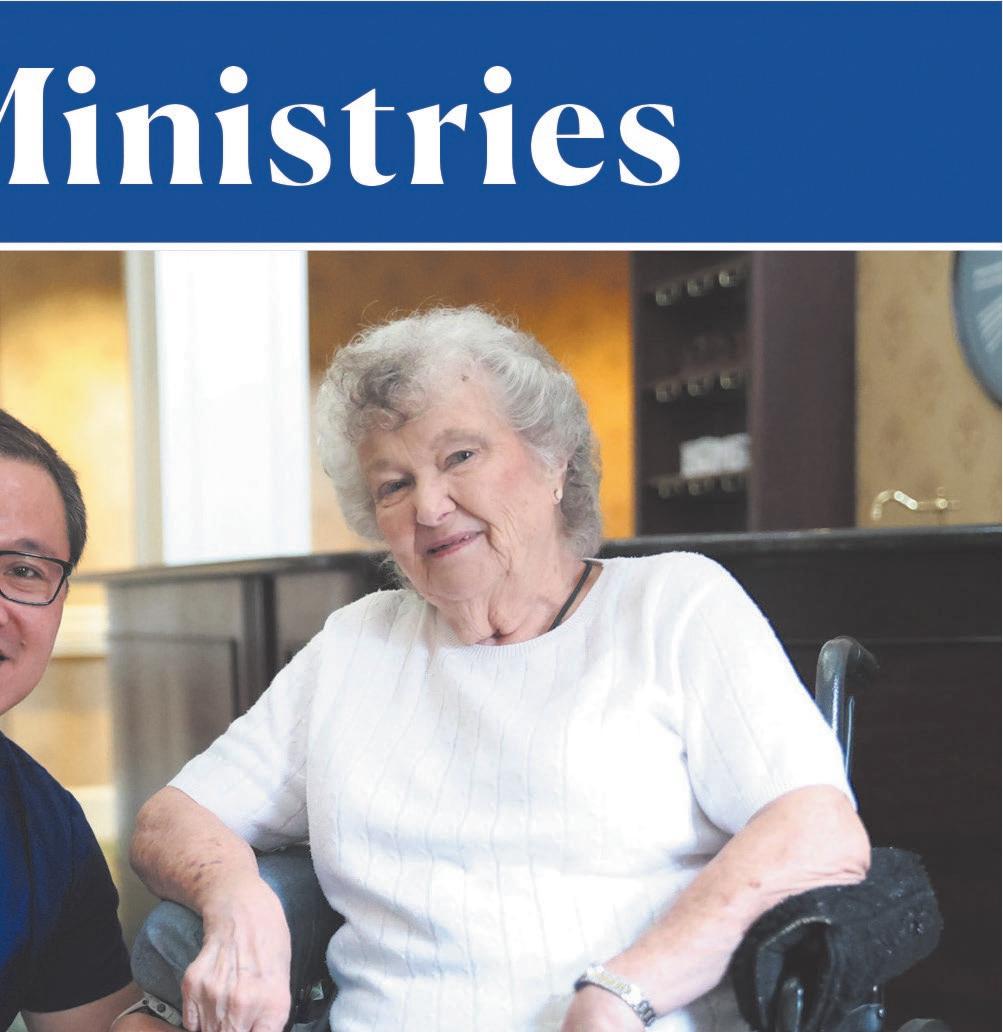



By Zach Petroff
At only 19 years old, a young aristocrat from south-central France embarked on a challenging and lengthy journey to volunteer with the Continental Army under Gen. George Washington.
In a letter to his wife, the young man expressed his admiration for the new nation: “The welfare of America is closely linked to the happiness of all humanity; she will become a respectable and secure refuge for virtue, integrity, tolerance, equality and peaceful liberty,” he wrote in 1777.
On May 30, residents of Fayette County commemorated Marquis de Lafayette’s pivotal role in the nation’s creation, reflecting on the enduring ideals of American exceptionalism and democracy.
“This commemoration is more than a history lesson. It is a reminder of what binds us…the belief that courage and conviction can move us forward,” said Muriel Nuttall, executive director of Fayette Chamber of Commerce.
The patriotic ceremony which took place at the State Theatre Center For the Arts in
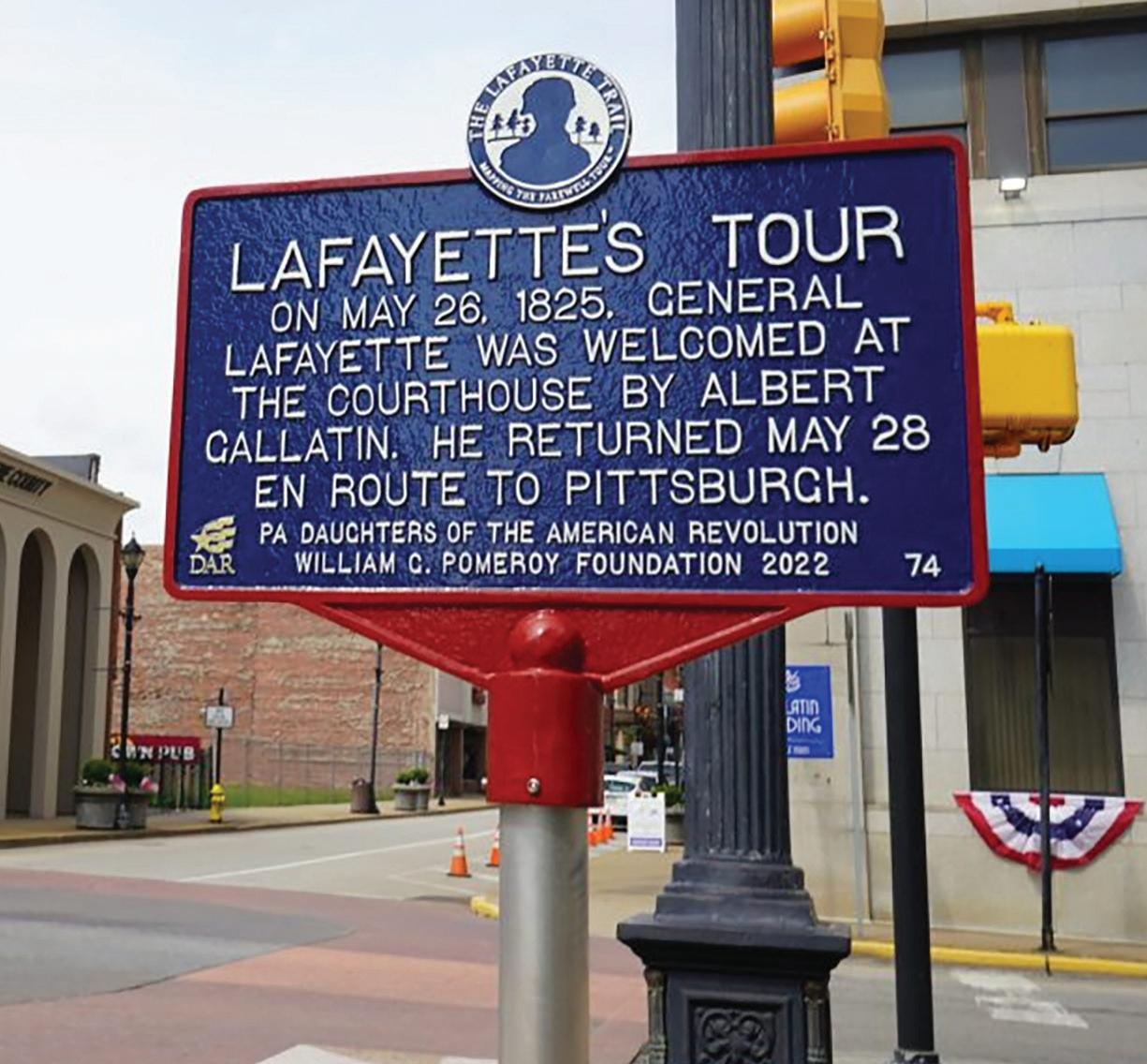

Matthew Mlynarski speaks at the commemorative ceremony for Marquis de Lafayette’s farewell tour at the State Theatre Center For the Arts in downtown Uniontown.
downtown Uniontown featured songs and people from the local and state legislature along with musical performances performed by the VFW band from Post 8543.
However, no honorary ceremony could be complete without hearing from the man himself.
Marie-Joseph Paul Yves Roch Gilbert du Motier, Marquis de Lafayette (his full name, comma and all) spoke to the crowd about his respect for the United States and how the birth of the nation brought forth the ideological hope of what freedom really means.
“I’m reminded of the sound and virtuous feeling and the truly Republican spirit in support of institutions founded on the rights of man, by which the United States are held up as an object of admiration, as a noble, evident, practical model to the rest of the
world,” Lafayette said.
The reenactor who took on the personage of the French aristocrat also made reference to how much he enjoyed coming back to his namesake, Fayette County.
“My delight is greatly enhanced by the affectionate welcome I receive in this county and in Uniontown,” he said.
And while the afternoon was built around the pageantry of patriotism and the roots of the county, 13-year-old Wesley Smolenski, who would later interview Laffayette for Fayette County TV, said Friday’s ceremony served as a reminder to why it is important to reflect on history.
“If you don’t know what happened in the past, it can repeat itself,” Smolenski said.
Courtesy of the Observer-Reporter
























































